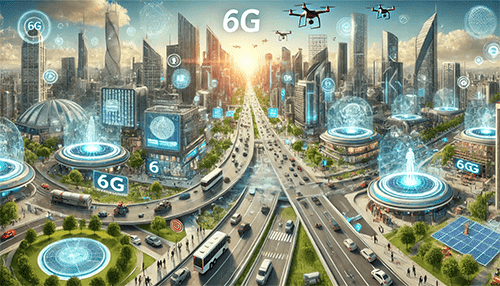Getting to Know 6G Technology: What Can We Expect?
As 5G technology continues to spread across the globe, experts are already looking toward the next step in wireless technology: 6G. Predicted to make its debut around 2030, 6G is anticipated to redefine the connectivity landscape in unimaginable ways. But what exactly is 6G technology, and what can we expect from it? Here, we delve into the fundamental concepts of 6G, the potential applications, and the challenges that lie ahead.
What is 6G Technology?
6G, or sixth-generation wireless technology, is the successor to 5G. While 5G introduced significant improvements over its predecessor, 4G, in terms of speed, latency, and connectivity, 6G is expected to elevate these enhancements to entirely new levels. Experts predict that 6G will be capable of delivering data speeds up to 1 terabit per second (Tbps), representing a leap that will enable technologies only imagined today.
This high-speed, low-latency wireless technology will primarily operate in the terahertz (THz) frequency spectrum, above the millimeter waves used by 5G. By leveraging higher frequencies, 6G will offer unprecedented data transmission speeds and network efficiency, supporting a new generation of digital experiences and technological advancements.
Key Features of 6G Technology
Unprecedented Speed and Capacity
6G networks are expected to offer speeds nearly 100 times faster than 5G, potentially reaching up to 1 Tbps. This rapid data transfer rate will enable complex tasks, such as real-time holographic communications, instant data transmission for connected vehicles, and seamless integration of virtual and augmented reality into everyday life.Ultra-Low Latency
With latency potentially under a millisecond, 6G technology will offer real-time data transfer capabilities that could revolutionize sectors reliant on instant information, like remote surgery, autonomous driving, and virtual collaboration. The ultra-low latency will provide an experience of instantaneous data transmission, further improving reliability and user experience.Enhanced Connectivity for IoT
As the Internet of Things (IoT) expands, 6G will support a massive number of connected devices with improved energy efficiency and range. This will enable intelligent cities and homes, where virtually all devices and appliances will communicate seamlessly with each other. In addition, 6G’s enhanced connectivity capabilities will extend to rural and remote areas, helping close the digital divide.Integration of AI and Machine Learning
Artificial intelligence (AI) and machine learning (ML) will play central roles in 6G technology. 6G networks are expected to feature self-optimizing capabilities, allowing them to adapt in real time based on data insights. This could enable dynamic resource allocation, enhance network security, and reduce energy consumption, making 6G smarter and more sustainable.Increased Focus on Security and Privacy
With enhanced capabilities come increased risks. Security and privacy will be key focuses for 6G technology. Advanced encryption methods, distributed ledger technology, and AI-based anomaly detection are expected to be integral to 6G’s infrastructure, protecting against cyber threats and ensuring data integrity.
Applications and Potential Uses of 6G Technology
Holographic Communication
Imagine attending a business meeting where your colleagues appear as three-dimensional holograms in the room. This futuristic vision is one of the potential applications of 6G. With extremely high bandwidth and low latency, 6G could make real-time holographic communication a reality, transforming remote work, education, and social interactions.Enhanced AR/VR Experiences
Virtual and augmented reality (AR/VR) will reach new levels with 6G. From fully immersive virtual classrooms to enhanced remote training for complex tasks, the high-speed, low-latency capabilities of 6G will make these experiences smoother and more realistic. Retail, entertainment, and healthcare are just a few sectors likely to benefit from this new AR/VR landscape.Autonomous Transportation
Self-driving cars and other autonomous vehicles require vast amounts of data to be transmitted and processed instantly. The ultra-low latency and reliability of 6G could support autonomous transportation systems, enabling faster response times and improving road safety. Smart transportation could also lead to more efficient traffic management and pollution reduction.Smart Cities and the Internet of Everything
With the expansion of 6G, cities will become more connected and efficient. From traffic lights that automatically adjust based on congestion to energy grids that optimize usage based on real-time demand, 6G will power the evolution of smart cities, improving urban life and reducing environmental impact.
Challenges and Considerations for 6G
While 6G holds exciting possibilities, it also presents significant challenges. One of the primary concerns is the infrastructure required to support 6G. The technology’s reliance on high-frequency THz waves means signals will have shorter ranges and be more susceptible to interference. Building a global 6G network will require substantial investment in new infrastructure, including a dense network of small cell towers and antennas.
Additionally, security and privacy will require careful consideration. As 6G enables massive data collection, the need for robust cybersecurity measures will be paramount. The use of AI in 6G networks could also raise ethical questions, including data privacy and the potential for AI-driven bias.
When Will 6G Become a Reality?
Although 6G technology is still in the research phase, several countries and tech giants are investing heavily in its development. South Korea, China, and Japan, along with companies like Samsung, Nokia, and Huawei, are leading 6G research efforts. Industry experts predict that 6G could start rolling out around 2030, with full deployment in the years that follow.
Conclusion: What to Expect from 6G Technology
6G technology promises to bring unprecedented speeds, ultra-low latency, and groundbreaking applications that could reshape society as we know it. From real-time holograms to autonomous transportation, 6G will enable experiences and innovations that are currently beyond our reach. However, achieving this level of advancement will require overcoming infrastructure challenges, addressing security concerns, and ensuring global cooperation. As we approach the 2030 milestone, the promise of 6G reminds us that technology will continue to evolve and redefine our digital future.

Post a Comment for " Getting to Know 6G Technology: What Can We Expect?"